The Effect of Seeking Resource Diversity on Post-Alliance Innovation Outcomes
IF 4
Q2 BUSINESS
引用次数: 2
Abstract
Prior research has studied the influence of R&D resource diversity, but such work only examined a single level of resource diversity. Although alliance partners engage in multiple levels of resource diversity to expand their organizational boundary, we have limited knowledge of how to utilize internal and between partners’ R&D resources. Drawing upon the perspectives of the tensions-based view and organizational boundary, we test the effects of three different levels of resource diversities, simultaneously, on post-alliance innovation outcomes. Using a dataset of 320 U.S. publicly traded firms that participated in a strategic alliance and had a patent filing between 1985 and 2010, our results reveal that internal R&D resource diversity, the R&D diversity between partners, and the similarity of industry level negatively effects innovative outcomes. However, both internal R&D resource diversity and similarity of industry level diminish the negative influence of newly acquired R&D resources from partners. We not only contribute to the existing body of work by investigating multiple levels of diversity but also provide insight to practitioners when engaging in such diversities with different levels.寻求资源多样性对联盟后创新成果的影响
已有研究对R&D资源多样性的影响进行了研究,但这些研究只考察了单个层面的资源多样性。尽管联盟伙伴通过多层次的资源多样性来扩展其组织边界,但我们对如何利用内部和合作伙伴之间的研发资源的了解有限。基于张力理论和组织边界理论,我们同时检验了三种不同层次的资源多样性对联盟后创新结果的影响。基于1985 ~ 2010年间参与战略联盟并提交专利申请的320家美国上市公司的数据,我们的研究结果表明,内部研发资源多样性、合作伙伴之间的研发多样性和行业水平相似性对创新成果具有负向影响。然而,企业内部研发资源的多样性和行业水平的相似性都会减弱合作伙伴新获得研发资源的负面影响。我们不仅通过调查多样性的多个层次来为现有的工作做出贡献,而且还为从事不同层次的多样性的从业者提供见解。
本文章由计算机程序翻译,如有差异,请以英文原文为准。
求助全文
约1分钟内获得全文
求助全文
来源期刊

Australasian Marketing Journal
BUSINESS-
CiteScore
14.90
自引率
16.70%
发文量
25
期刊介绍:
The Australasian Marketing Journal (AMJ) is the official journal of the Australian and New Zealand Marketing Academy (ANZMAC). It is an academic journal for the dissemination of leading studies in marketing, for researchers, students, educators, scholars, and practitioners. The objective of the AMJ is to publish articles that enrich and contribute to the advancement of the discipline and the practice of marketing. Therefore, manuscripts accepted for publication will be theoretically sound, offer significant research findings and insights, and suggest meaningful implications and recommendations. Articles reporting original empirical research should include defensible methodology and findings consistent with rigorous academic standards.
 求助内容:
求助内容: 应助结果提醒方式:
应助结果提醒方式:


